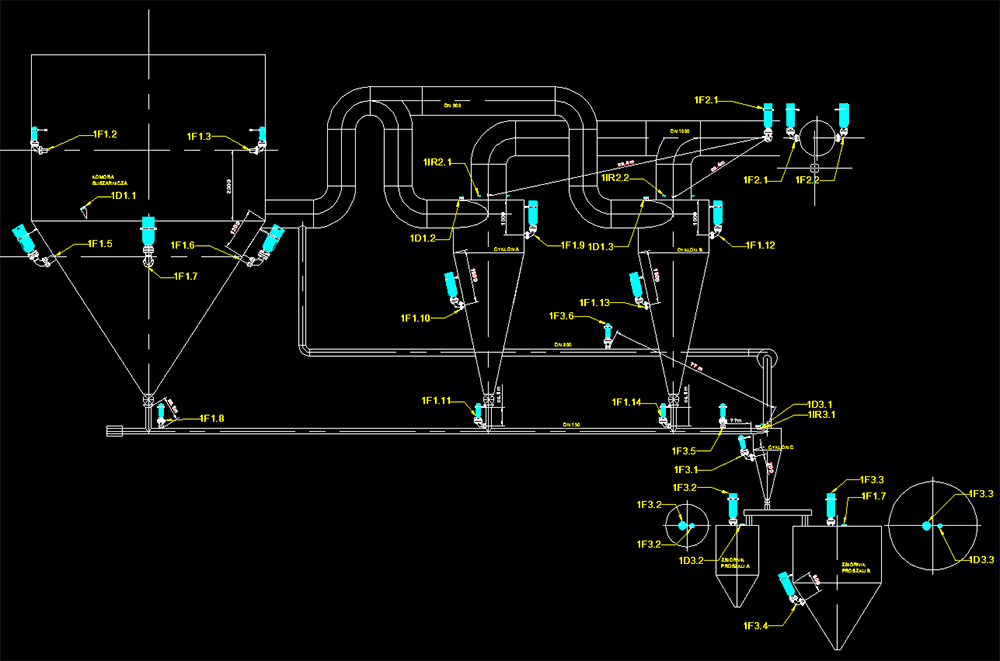Problem:
- Spray drying installations often pose a risk of explosion and fire.
- A manufacturer from the food industry, aware of the risk, asked us to prepare an explosion protection document (EPD).
- The first conversation showed that it is too early to develop an EPD in this case.
Remedy
- We proposed an ATEX AUDIT, during which we showed non-conformities, including their severity and presented the concept of securing the dryer against explosion.
- This provides the basis for development of a corrective action schedule adapted to the capacity of the site.
- In order to make the client feel safe, we proposed that the cost of the future EPD document shall be reduced by the price of the AUDIT.
We pointed out the non-conformities
Without additional charges
We took into account the capacity of the client
A few months ago we experienced a situation which later proved to be recurring.
We were asked to prepare an explosion protection document by a representative of a site using a spray drying system in its process. However, the initial interview already revealed several key non-conformities in the area of explosion safety.
What could we have done?
On one hand, we had a client willing to pay for preparation of an explosion protection document.
On the other hand, we were aware of explosion safety non-conformities that would reduce the value of the document. As Bartosz Wolff once said: “We do not want to be just another anonymous company based on superficial, fast-food-like relationships. We are looking for more in business – trust, partnership and a actual, human experience.” For this reason, we proposed a different solution, safer for the client.
Document at a fraction of the cost
We convinced the client to conduct an ATEX AUDIT… an audit that costs only a fraction of the cost of an EPD document and takes five times less time to complete. We also guaranteed the client that if the client decides to order an EPD preparation with us, its cost will be reduced by the audit price.
It was a fair proposal. The customer risked nothing… lost nothing… And could only gain.
For the price of the EPD, the client would additionally receive an ATEX AUDIT, which presents any non-conformities related to explosion safety. And this is not all yet. The AUDIT indicates tasks that should be implemented as a priority, in order to provide the best possible improvement of explosion safety and thus – of fire safety.
In other words, instead of revolution, we proposed evolution… instead of fixing everything at once, we recommended change at a pace fitting the capacity of the client.
We currently use this model of cooperation always when the initial conversation reveals that the client is facing significant non-conformities related to explosion safety. This approach builds a partnership and allows the works schedule to be developed together.
What does an ATEX AUDIT look like and which questions does it answer?
The audit begins with an interview and collection of available documents. After an initial analysis of the documents, a site visit takes place. During the site inspection, the auditor gets acquainted with the installation, its technical condition, applied safeguards, and prepares photographic documentation. Photos are an important part of the audit, as they allow the references to individual equipment, process junctions or premises in the document.
The result of the audit provides the answer i.e. to the following questions:
| Analysed area | What if non-conformities are identified? |
| Does the site have a list of explosive substances and their key explosive and flammable properties | In the audit, we indicate which substances may pose an explosion hazard and present their explosion-related parameters – on the basis of our databases with parameters of several thousand dusts. This data will be used for preliminary determination of the hazard level and in preparation of a security concept. For the purpose of EPD preparation and for the final selection of protective measures, we recommend tests of the actual dusts present in the installation |
| Does the site have all the documents required by law and necessary to prepare the EPD? | Missing documents and the consequences thereof shall be indicated |
| Does the site have technical safety measures against ignition of ignition sources, adequate for the safety level (e.g. EX equipment variants, protection against static electricity, magnetic separators, etc.) | Missing safety measures and consequences thereof shall be indicated |
| Does the site have the required procedures influencing the explosion safety level | Missing procedures and consequences thereof shall be indicated |
| Does the equipment exposed to explosion hazard meets the relevant requirements applicable to documentation | Missing documents and the consequences thereof shall be indicated |
| Is the equipment exposed to an explosion hazard provided with adequate safety measures (protection against formation of explosive atmospheres, sources of ignition, explosion consequences) | Non-conformities or possible errors related to explosion protection will be pointed out, including their consequences. Upon request, a concept of adequate explosion protection will be proposed to the client, indicating the optimal safety measures, including their parameters and layout. |
Result of the ATEX AUDIT for the dryer
The 25-page document showed non-conformities or errors in 15 areas. The most important ones included:
- lack of parameters related to explosive properties and flammability of produced powders;
- lack of explosion protection minimising the consequences of an explosion in the installation;
- lack of procedures for safe removal of dusts with the potential of explosive atmosphere formation from floors, supporting structures and equipment;
- use of electrical equipment in standard variants within Ex zones (a potential ignition source).
The concept of installation protection against explosion
The audit also included preparation of a concept of installation protection against consequences of a dust explosion. As the plant is located inside the hall and because of other important technical issues, explosion suppression and isolation using HRD cylinders was proposed as a protective system.

The concept of installation protection against explosion
The required calculations were made to select the number of cylinders, their capacities and locations. The calculations used explosion-related parameters of dust from available databases.
Such data is sufficient for the development of a preliminary concept enabling estimation of costs of protective measures. At the same time, we recommended tests intended to determine the actual parameters of dusts from the installation. We will update the concept once the tests are performed. Such an update usually involves a change in the location of individual components of the protective system components. This means installation locations of sensors and HRD cylinders.
The drying process
The audited installation is designed for production of flavourings in the form of powders. This process is carried out by spray drying concentrated juices mixed with a maltodextrin carrier. The aforementioned installation includes:
- spray dryer,
- 3 cyclones,
- 2 powder hoppers.
Both the liquid raw material and hot air at approx. 190°C are fed to the spray dryer from above. The fluid falls onto a spinning disk transforming it into millions of tiny droplets. By the time the droplets fall to the bottom of the dryer, they turn into a fine powder… a powder that can create an explosive atmosphere with air.
The finest fraction together with hot air enters the system of two large cyclones. The thicker fraction is in turn collected in the conical part of the dryer, from where it is directed to the third, smaller cyclone through a cell valve and a pneumatic transport system. Both fractions separated in all three cyclones enter two tanks and, subsequently, big-bags or paper sacks.
Why we started with an ATEX AUDIT
“Lack of data”… “incomplete material”… “documentation to be completed” – such insignificant phrases can be used to fill out an explosion protection document when the site lacks the key data for its preparation. Preparing a document intended to demonstrate that the plant meets the explosion safety requirements is not necessarily a good idea at this point in time.
Why? Because such an EPD document would be incomplete and ambiguous. Many important issues would have to be omitted. At best, some of them could be replaced by assumptions… realistic assumptions, but still assumptions inherently fraught with the risk of errors… errors with potentially really serious consequences.
Therefore and inter alia, the ideal solution would be to prepare an EPD document when the minimum requirements specified in the so-called ATEX USER Directive are met.
80% of sites do not meet the minimum requirements
However, here comes a clash with reality – according to our experience, 80% of industrial plants do not meet these minimum requirements at the time of requesting preparation of an explosion protection document or explosion risk assessment.
Companies that prepare such documents have been trying to deal with this problem. For example, our engineers have made it a rule that in such situations they prepare an EPD in the form of a roadmap to enable the client to reach the goal of meeting the minimum legal requirements. As a result, we provided recommendations in the EPD and the ORW which, if implemented, would allow these legal requirements to be met. This required extra work on our part, but without it we would have left the client without any support.
The concept seemed right, but once again the reality verified it. Unfortunately, such an approach usually resulted in the client feeling overwhelmed… they did not know where to start… or even what arguments to use when talking to their superiors or headquarters. After all, change required investment, and that investment required the acceptance of measures.





